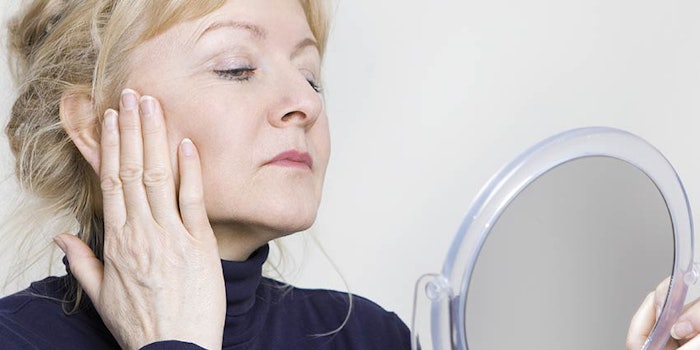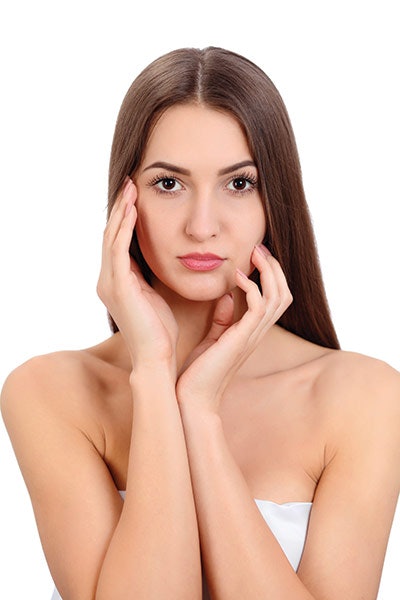
Many people associate hormonal fluctuations with women and teens, but these chemical messengers go up and down in all walks of life—male and female, as well as young and old. It is important for skin care professionals to be knowledgeable about hormones for a number of reasons. Being able to associate hormonal fluctuations with the phases of life will help skin care practitioners address certain skin changes regarding oil, hydration and loss of skin elasticity. Of course, if hormonal fluctuations are not tied to life’s phases, being knowledgeable of the more common hormonal disorders and how they affect the skin will help skin care professionals guide clients to achieving skin care goals.
T3 and T4
The thyroid is part of the endocrine system, which is made up of glands that produce, store and release hormones into the bloodstream so the hormones can reach the body’s cells. This gland utilizes the iodine in foods to produce two main hormones, triiodothyronine (T3) and thyroxine (T4). These two hormones affect the body’s metabolism, temperature, blood, heart and nervous system, which can have an effect on the skin.
Effects on skin. Usually when this hormone is off, a physician will prescribe a drug that will attempt to bring the level back to normal.1 Too little thyroid hormones can cause the skin to become more dry, cool, pale and brittle. There is also a skin condition named carotenaemia that causes the skin to turn more yellow in color. When a person has dry skin, they become more susceptible to inflammation and eczema. Too much thyroid hormone can lead to warm, moist and sometimes rash-prone skin. Some more extreme cases of hyperthyroid may have Graves’ disease, which may cause vitiligo, a condition characterized by irregularly shaped white patches on the skin resulting from the destruction of pigment cells.

Estrogen
Estrogen is another hormone that can affect the skin in a variety of ways when levels are varied. Estrogen is naturally produced in the bodies of both men and women. Its main role in the body is to help manage the reproductive system as well as help skin heal from bruises and protect the bones.
Effects on skin. As the body ages, the levels of estrogen decline and the skin can become more fragile, dry and loose. Loss of estrogen is a major cause of sagging, dry skin in women over 40. When estrogen levels are on the high end of spectrum, melasma (most common in pregnant women) can occur or even may cause premenstrual symptoms to be more severe. If a person’s estrogen is not being metabolized in a normal manner, it can lead to a variety of cancers, including breast cancer. Estrogen can also signal sub-hormones to cause overgrowth of tissue that causes endometriosis. This disease affects up to 10% of women, which can cause painful and heavy menstrual cycles as well as issues with infertility.2 Endometriosis can cause side effects in skin, including more oil and easily hyperpigmented conditions.
Testosterone
Testosterone is a hormone that is responsible for many of the physical characteristics specific to adult males. It is one of the principal androgen hormones, and it plays a key role in reproduction and the maintenance of bone and muscle strength. It is also a hormone that is present in females but predominately at much lower levels. Testosterone can affect the skin in many ways, both for men and women.
Effects on skin. For men, it can help to thicken the tissue surrounding the dermal and epidermal layers. The thicker tissues may promote more collagen production and more elasticity. Obviously, it helps in building larger muscles. Men also tend to have larger pores than women, as testosterone motivates the sebaceous glands to produce more sebum, which makes the skin supple. Too much testosterone in men can lead to acne. The testosterone hormone in men also promotes hair growth all over the body, especially in the facial area. The hair offers a protection for the skin. When there is hair growth as well as normal sebaceous glands for a man, there also tends to be fewer wrinkles. In contrast, men experience hair loss when testosterone levels are low.3
Women can have issues with testosterone as well and should have those levels checked. When testosterone is too low, skin loses elasticity, tone and becomes drier, whereas high levels can cause the sebaceous glands to overproduce sebum and lead to cystic acne. The skin can become more sensitive in nature. Increased levels of testosterone in women may also lead to more facial hair. This is quite evident when the body overproduces testosterone at times to cause a woman to have Polycystic Ovarian Syndrome (PCOS). When a client has this, typical treatments for hair removal and acne are not effective until a physician can get the levels under control, as the symptoms will continue until that happens.4
Cortisol
Cortisol is a hormone that most attribute to weight gain when stress levels are high. It also can have an effect on the skin—as stress levels increase, rising cortisol levels can cause acne breakouts and even premature aging. In rare cases, clients can get Cushing’s disease, which causes the skin to bruise easily and become thin and dry, along with acne and purple striation marks.5

Teens
Uneven hormone levels start in the preteen years. Girls may start puberty and their menstrual cycle as early as 8 years old (average is 12 years old), while boys can start puberty as early as 9 years old (average is 12 years old).6 It may take several years to go through the full cycle of puberty. At ages 8 and 9, the skin is still youthful rather than reflecting teenage skin. Many preteen girls are actually prescribed birth control pills to regulate their cycles, as they can be heavy or irregular. Many teens are also prescribed a variety of medications from dermatologists that work on the skin from inside out.
Treatment room. When working on teens in the treatment room, a combination of deep cleansing treatments, enzymes and light-to-medium peels are effective. Home care should include products that are antibacterial, antimicrobial, anti-inflammatory, soothing and hydrating. Vitamin A derivatives, salicylic acid, totarol and benzoyl peroxide-like ingredients such as Glycyrrhiza inflata root extract (licorice) can be effective for oil control. Take into consideration birth control or any other medications the teen is taking when deciding on home care and possible treatments in the spa setting to avoid any contraindications.
Years 20–40
Most hope that acne breakouts end after the teen years, but many women still have hormonal breakouts between ages 20 and 40. It is most helpful to treat these as a breakout rather than all over the face. This age range often is when women typically decide to have children. Pregnancy can also cause issues with the skin and nails. Some get melasma (pregnancy mask), where melanin is overproduced, and a hyperpigmented mask develops on the face. When treating someone who is pregnant, the less aggressive the better. Use natural brighteners like daisy, bearberry or licorice root rather than traditional, more aggressive hydroquinone and heavy peels until after pregnancy when hormone levels go back to normal.

Years 40+ and Menopause
Clients in the 40+ age group are going through hormonal changes as well. Menopause can happen naturally as women age or it can be induced prematurely due to illnesses, surgeries and medications. Because the main source of female hormones, the ovaries, shut down at this time, many side effects can be seen in the skin. Every woman experiences menopause differently, and treatments may need to be altered to address what is going on with their skin at different periods of time.
A client’s skin can be affected by a variety of issues during menopause, such as thinning, dryness, excessive hair growth in odd places and even hair loss. When a person ages, the skin also becomes more sensitive, so traditional aggressive treatments and products used during youth may need to be altered because they are too stimulating for skin during these hormonal changes. Clients will still want anti-aging ingredients, such as peptides, alpha hydroxy acids (AHAs), forms of retinol and antioxidants, but they need to be cautious when dealing with more sensitive skin.
An example would be to use retinaldehyde, which is a gentler derivative of vitamin A versus Retin-A or retinol, which cause redness and peeling to the skin. As clients age, more medications will come into play due to illnesses that come with aging. They will also play an important part in your consultations. The skin care professional needs to create treatments to avoid a reaction on the skin, but still give the results of rejuvenated, healthier-looking skin the client desires.
Encourage Hormone Checks
Hormonal issues can happen to both the male and female client. Hormonal skin issues are easier to deal with if the client and skin care professional are both aware of what is really causing problems on the skin—that is why it is so important to have a good intake form. Asking questions about health and medications will give a better overview of a client, so one can create a good treatment and home care plan.
When the client is having issues with their skin that you suspect could be associated with hormonal fluctuations, encourage the client to get their hormones checked. This could be at any life stage. If levels are off, they may be given a prescription to help balance out hormones or even take the more natural route with supplements. Either way, it will be much easier to help the client achieve their skin care goals.
REFERENCES












